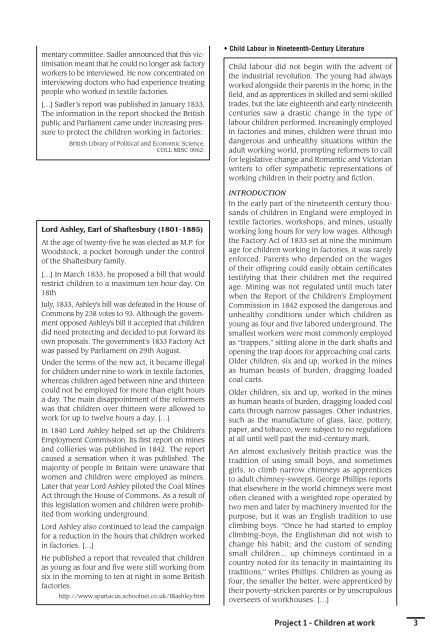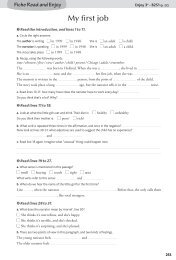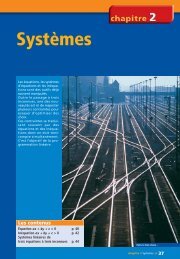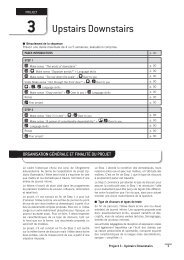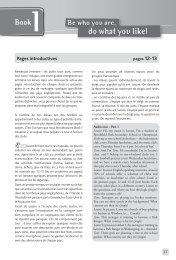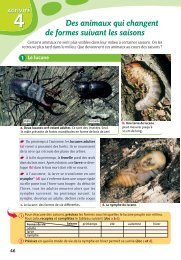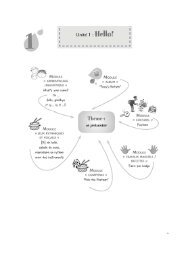Children at work - Didier
Children at work - Didier
Children at work - Didier
You also want an ePaper? Increase the reach of your titles
YUMPU automatically turns print PDFs into web optimized ePapers that Google loves.
mentary committee. Sadler announced th<strong>at</strong> this victimis<strong>at</strong>ion<br />
meant th<strong>at</strong> he could no longer ask factory<br />
<strong>work</strong>ers to be interviewed. He now concentr<strong>at</strong>ed on<br />
interviewing doctors who had experience tre<strong>at</strong>ing<br />
people who <strong>work</strong>ed in textile factories.<br />
[…] Sadler’s report was published in January 1833.<br />
The inform<strong>at</strong>ion in the report shocked the British<br />
public and Parliament came under increasing pressure<br />
to protect the children <strong>work</strong>ing in factories.<br />
British Library of Political and Economic Science,<br />
COLL MISC 0062.<br />
Lord Ashley, Earl of Shaftesbury (1801-1885)<br />
At the age of twenty-five he was elected as M.P. for<br />
Woodstock, a pocket borough under the control<br />
of the Shaftesbury family.<br />
[…] In March 1833, he proposed a bill th<strong>at</strong> would<br />
restrict children to a maximum ten hour day. On<br />
18th<br />
July, 1833, Ashley’s bill was defe<strong>at</strong>ed in the House of<br />
Commons by 238 votes to 93. Although the government<br />
opposed Ashley’s bill it accepted th<strong>at</strong> children<br />
did need protecting and decided to put forward its<br />
own proposals. The government’s 1833 Factory Act<br />
was passed by Parliament on 29th August.<br />
Under the terms of the new act, it became illegal<br />
for children under nine to <strong>work</strong> in textile factories,<br />
whereas children aged between nine and thirteen<br />
could not be employed for more than eight hours<br />
a day. The main disappointment of the reformers<br />
was th<strong>at</strong> children over thirteen were allowed to<br />
<strong>work</strong> for up to twelve hours a day. […]<br />
In 1840 Lord Ashley helped set up the <strong>Children</strong>’s<br />
Employment Commission. Its first report on mines<br />
and collieries was published in 1842. The report<br />
caused a sens<strong>at</strong>ion when it was published. The<br />
majority of people in Britain were unaware th<strong>at</strong><br />
women and children were employed as miners.<br />
L<strong>at</strong>er th<strong>at</strong> year Lord Ashley piloted the Coal Mines<br />
Act through the House of Commons. As a result of<br />
this legisl<strong>at</strong>ion women and children were prohibited<br />
from <strong>work</strong>ing underground.<br />
Lord Ashley also continued to lead the campaign<br />
for a reduction in the hours th<strong>at</strong> children <strong>work</strong>ed<br />
in factories. […]<br />
He published a report th<strong>at</strong> revealed th<strong>at</strong> children<br />
as young as four and five were still <strong>work</strong>ing from<br />
six in the morning to ten <strong>at</strong> night in some British<br />
factories.<br />
http://www.spartacus.schoolnet.co.uk/IRashley.htm<br />
• Child Labour in Nineteenth-Century Liter<strong>at</strong>ure<br />
Child labour did not begin with the advent of<br />
the industrial revolution. The young had always<br />
<strong>work</strong>ed alongside their parents in the home, in the<br />
field, and as apprentices in skilled and semi-skilled<br />
trades, but the l<strong>at</strong>e eighteenth and early nineteenth<br />
centuries saw a drastic change in the type of<br />
labour children performed. Increasingly employed<br />
in factories and mines, children were thrust into<br />
dangerous and unhealthy situ<strong>at</strong>ions within the<br />
adult <strong>work</strong>ing world, prompting reformers to call<br />
for legisl<strong>at</strong>ive change and Romantic and Victorian<br />
writers to offer symp<strong>at</strong>hetic represent<strong>at</strong>ions of<br />
<strong>work</strong>ing children in their poetry and fiction.<br />
INTRODUCTION<br />
In the early part of the nineteenth century thousands<br />
of children in England were employed in<br />
textile factories, <strong>work</strong>shops, and mines, usually<br />
<strong>work</strong>ing long hours for very low wages. Although<br />
the Factory Act of 1833 set <strong>at</strong> nine the minimum<br />
age for children <strong>work</strong>ing in factories, it was rarely<br />
enforced. Parents who depended on the wages<br />
of their offspring could easily obtain certific<strong>at</strong>es<br />
testifying th<strong>at</strong> their children met the required<br />
age. Mining was not regul<strong>at</strong>ed until much l<strong>at</strong>er<br />
when the Report of the <strong>Children</strong>’s Employment<br />
Commission in 1842 exposed the dangerous and<br />
unhealthy conditions under which children as<br />
young as four and five labored underground. The<br />
smallest <strong>work</strong>ers were most commonly employed<br />
as “trappers,” sitting alone in the dark shafts and<br />
opening the trap doors for approaching coal carts.<br />
Older children, six and up, <strong>work</strong>ed in the mines<br />
as human beasts of burden, dragging loaded<br />
coal carts.<br />
Older children, six and up, <strong>work</strong>ed in the mines<br />
as human beasts of burden, dragging loaded coal<br />
carts through narrow passages. Other industries,<br />
such as the manufacture of glass, lace, pottery,<br />
paper, and tobacco, were subject to no regul<strong>at</strong>ions<br />
<strong>at</strong> all until well past the mid-century mark.<br />
An almost exclusively British practice was the<br />
tradition of using small boys, and sometimes<br />
girls, to climb narrow chimneys as apprentices<br />
to adult chimney-sweeps. George Phillips reports<br />
th<strong>at</strong> elsewhere in the world chimneys were most<br />
often cleaned with a weighted rope oper<strong>at</strong>ed by<br />
two men and l<strong>at</strong>er by machinery invented for the<br />
purpose, but it was an English tradition to use<br />
climbing boys. “Once he had started to employ<br />
climbing-boys, the Englishman did not wish to<br />
change his habit; and the custom of sending<br />
small children… up chimneys continued in a<br />
country noted for its tenacity in maintaining its<br />
traditions,” writes Phillips. <strong>Children</strong> as young as<br />
four, the smaller the better, were apprenticed by<br />
their poverty-stricken parents or by unscrupulous<br />
overseers of <strong>work</strong>houses. […]<br />
Project 1 - <strong>Children</strong> <strong>at</strong> <strong>work</strong><br />
3


